Have you noticed tiny red bites on your skin or that of a loved one when you wake up in the morning? If you’re concerned about a potential infestation in your home and want to determine whether these are bed bug bites, you’re in the right place.
We understand and see it very often. The idea of something feeding on you in the night is disturbing, and you’re definitely justified in panicking. You probably suspect you have bed bugs, and you might, but often, what seems like a bed bug infestation is actually a flea infestation or, as is quite common, an infestation of carpet beetles.
With bed bugs and carpet beetles, what’s the difference? Unlike bed bugs, carpet beetles do not bite and cause an allergic reaction. So which do you have? We’re here to help!
Identifying bed bug bites and carpet beetle bites is one way to find out which is in your home. Let’s go over some of the details of bed bug and carpet beetle infestations so you can have a better idea of what’s happening in your home by looking at these insects’ appearances and bite markings.
Carpet beetles and bed bugs can have similar “bite” patterns and inhabit many of the same locations in your home. Both can be difficult to detect, and have many of the same results: itchy “bites” that occur while you sleep in your bed. They can be very easily confused with each other. Here’s what you need to know to best determine which infestation has taken root in your home.
How to Identify by Appearance
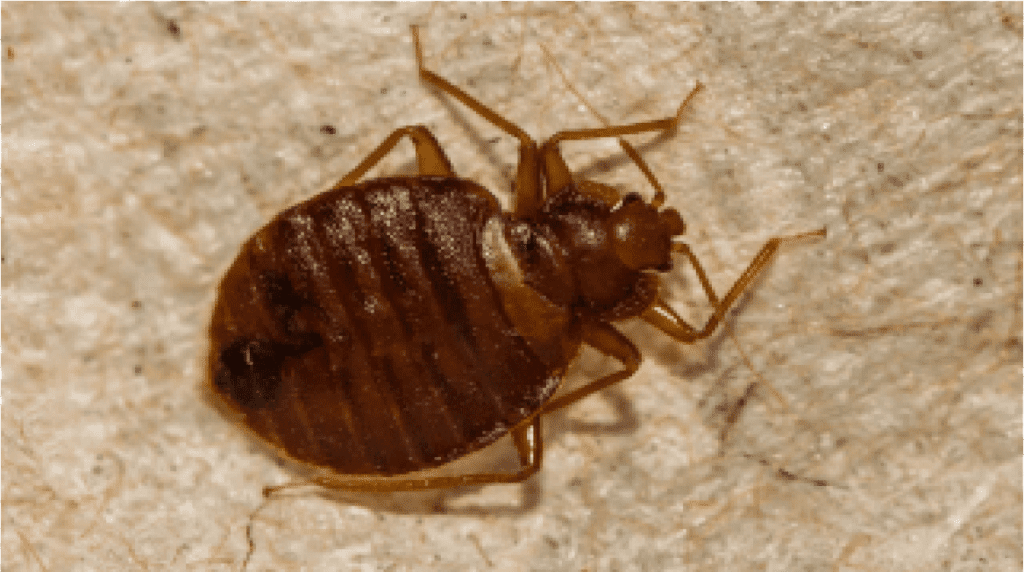
Bed Bugs
Bed bugs are usually reddish and semitranslucent. They often cluster in the seams of your bed or near the trim that separates your carpet from the walls. They may be seen in the daytime or at night depending on your sleep patterns and the level of infestation, but are most likely to be active whenever you are sleeping.

Carpet Beetles
Carpet beetles are usually quite small, but adult carpet beetles can grow to nearly ladybug size. After a larval stage, they can be found in carpeting, along trim, in your windowsills, your bedding, and just about anywhere. In the Pacific Northwest, they have a black, brown, and grey color pattern, but black and blue is common, as well.
Bed Bugs vs Carpet Beetle Bites
People react differently to affects of bed bugs and carpet beetles. Two people sleeping in the same bed may both be getting bitten by bed bugs but one person is covered in red bite marks and the other has no apparent bite marks at all. Therefore, trying to identify insect type based strictly on bite patterns or skin appearance is not recommended.

Bed Bugs
Bed bugs require a “blood meal” to grow and reproduce, and they will have this meal many times during their life span. The feeding often leaves bite marks on your skin, and these may or may not appear in groups of three as is commonly believed.
They are attracted to the carbon dioxide and your slowed breathing as you sleep or rest–such as when you watch tv. Bed bugs will adapt to be active whenever you sleep whether that be at night or in the daytime and will actively seek you out for a blood meal. We have seen them travel between where they live and a blood meal up to about 30 feet and they will even relocate to other rooms, in search of a meal, fairly quickly if their food source (you) is absent long enough.
Infestations begin small but can quickly increase, especially if they’ve been feeding on you or a family member for months. An adult female can lay up to five eggs per day, without end, so long as she’s able to feed at night. Bedbugs will infest your home, specifically to feed on you, so they can grow and reproduce, and that is their end goal.
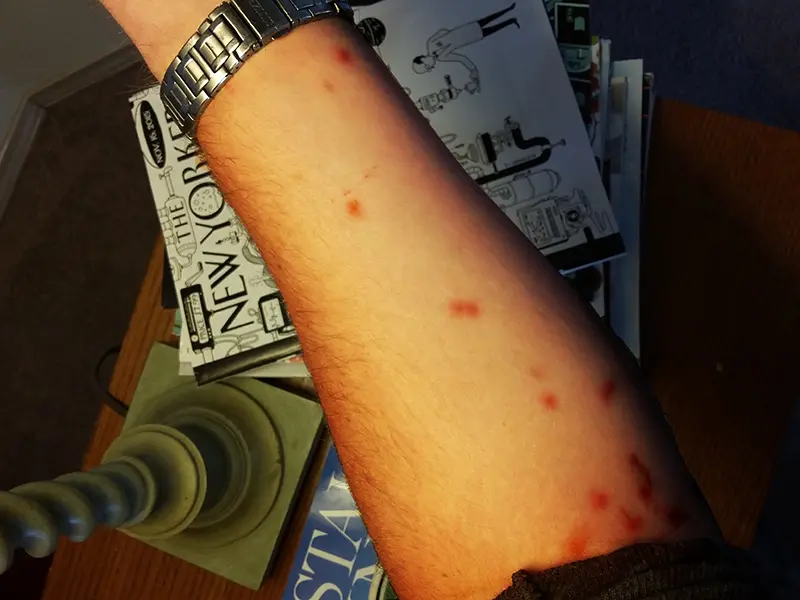
Carpet Beetles
Carpet beetles end up in our homes somewhat accidentally, and they do not need humans as a part of their diet or life cycle. They can be brought in on feathers, older bedding, wool (especially), on pets, and even in some bulk grains. They do not feed on people, but rather, they simply end up on us as they forage for food and water. The “bites” they leave behind on us are actually not bites at all.
Carpet beetles have tiny filaments, like small hairs, on their bodies, and these can cause an allergic reaction in humans. As these insects crawl across you, or drop these hairs on surfaces you contact, the hairs irritate your skin and can bring about small rashes or marks as an allergic reaction, which do look very much like bites but are actually just skin irritation. This is called carpet beetle dermatitis and is not commonly dangerous to one’s health. The allergic reaction may become more severe over time, and often, a carpet beetle infestation will go under the radar until someone begins having the reaction, which can take time to build up. At this point, the infestation may have grown quite large. By the time you realize there’s a problem, a sizable infestation is likely already present in your home.
Larval Stages of Bed Bugs and Carpet Beetles
One big difference between bed bugs and carpet beetles that can help you determine which pest you’re dealing with are differences in the larval stage of each.

Bed bugs go through an “incomplete” metamorphosis while carpet beetles go through a “complete” metamorphosis. What this means is that bed bugs have no larval stage. They hatch from eggs looking somewhat like miniature versions of adults. Carpet beetle eggs hatch into larvae, which have a different appearance than adults do. Carpet beetle larvae are actually larger than their adult forms are and resemble wormlike tiny creatures or even small silverfish.
The larvae can be found in your carpet, especially near the trim where the carpet meets the wall; under your bed; and in small carpeted nooks and crannies. What does this mean to you? If you find larvae in your bedroom, chances are high that you have a carpet beetle infestation and not that of bed bugs. While it’s possible to have both, that’s usually fairly rare.
How to Get Rid of Carpet Beetles: The DIY Route
Carpet beetles may not be disease-carrying insects, but because they have a huge appetite, they are likely to be a problem at your home. These creatures may rely on natural fibers for their food source and end up ruining whatever fabrics, clothing, or upholstery you have. If you have the time and want to try handling things yourself, you can try the following to avoid or purge an infestation of carpet beetles:
- Steam-clean or vacuum items. Carpet beetles are attracted to dust bunnies, animal hair, and lint, so usually thorough vacuuming of hard to reach areas is the first step. Make sure to clean those hard-to-reach, dark corners thoroughly and regularly because carpet beetles thrive in undisturbed areas with plenty of dust. We suggest vacumming under beds and dressers and other carpeted areas that rarely get cleaned. If you prefer a stronger option, steam-clean your carpets so the heat will kill the carpet beetles. You may have to steam-clean multiple times just to make sure the larvae and eggs are completely gone.
- Use white vinegar or apple cider vinegar (without water). This is another common home remedy that may help. Simply pour the vinegar into an atomizer spray bottle, and spritz on fabrics or places where carpet beetles are likely to infest. Alternatively, you can mix peppermint oil and clove oil with water and spray this on such surfaces. If you find carpet beetles on your clothes or textiles, you can wash these items in a mixture of vinegar and water or in soapy, hot water. Take note, though, that there are certain items and fabrics that should not be washed with vinegar; otherwise, they can be damaged or ruined. Carpet beetles are especially fond of wool and silk, but you should check first if they can be washed using the washing machine. Otherwise, these should just be hand-washed.
- Use vacuum pack bags. Clothes that are worn only during certain seasons or special occasions should be kept in garment bags so they don’t accumulate dust or attract carpet beetles.
- Seal all possible entry points. Use caulk to seal holes, cracks, and crevices where carpet beetles may pass or enter. For windows, use bug guards, and if your screen doors need fixing, use screen repair tape.
Call the Experts
In contrast to DIY methods that are often just temporary solutions, so if the infestation persists or you don’t have the time to get rid of carpet beetles yourself, you can give us a call anytime to schedule a PRO treatment. Regardless of which pest you’re dealing with, we can help. Bug Zapper Pest Control gets 5-star reviews because we are no stranger to bed bugs or carpet beetles, and we can rid you of these pests professionally and quickly. Our 100% guarantee means that you’ll be pest-free in no time, and our can-do attitude and fast response time are instrumental in helping you solve your pest problems!

As you can see, the “bite” patterns of Carpet Beetles vs. Bed Bugs, despite being different, still look very similar. They can sometimes be very difficult to determine. Our team of experts can help you determine with certainty which you have.
Check out this helpful video for more information about Bed Bugs
If you need an inspection to determine if you have bed bugs or carpet beetles contact us or give us a call to talk with our friendly and knowledgeable staff.
5 Star Pest Control Service available in Albany, Ashland, Corvallis, Eugene, Grants Pass, McMinnville, Medford, Newberg, Roseburg, Salem, Sherwood, Wilsonville, Woodburn, Tigard, Tualatin and surrounding areas.

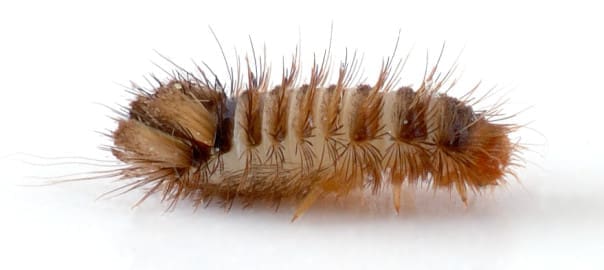

 Rat Control Facts You Need to Know!
Rat Control Facts You Need to Know! How to Keep Your Pets Safe During Pest Control
How to Keep Your Pets Safe During Pest Control Getting Rid of Mice
Getting Rid of Mice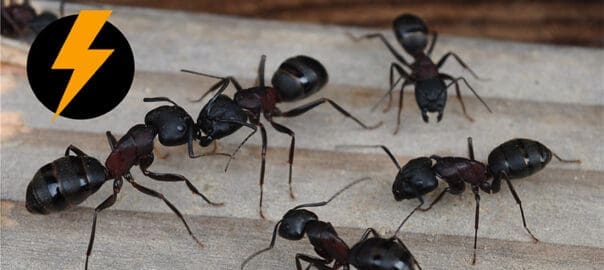 Carpenter Ant Identification & Prevention Tips
Carpenter Ant Identification & Prevention Tips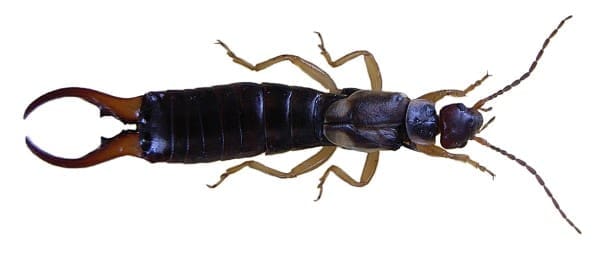 Bugs with Pincers: Everything You Need to Know about Earwigs
Bugs with Pincers: Everything You Need to Know about Earwigs